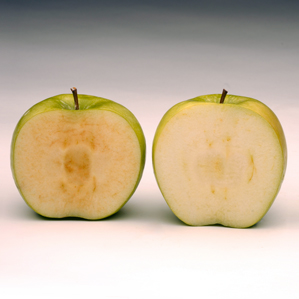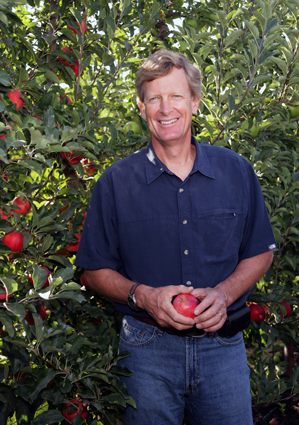Creating a Better Apple
The Arctic apple is the creation of Okanagan Specialty Fruits, a eight-person company in Canada that scrimped and saved over 18 years to win approval for Granny Smith and Golden Delicious apples that, because of clever genetic engineering, don’t brown as fast after they’re sliced.

The fruit could give a boost to the apple industry, which hasn’t seen much growth in consumption since the 1980s. Non-browning apples could be presliced and left on shelves for a couple of weeks, perhaps creating a new market for kids’ snacks, for example.
Most genetically modified organisms (GMOs) have been created by agrochemical companies that can spend heavily on developing and commercializing them. A 2011 study put the average cost of bringing a GM plant to market—including R&D, test plots, and wrangling with regulators—at about $130 million.
That explains why of the 112 GM plants cleared by the U.S. Department of Agriculture, nearly half are now owned by a single company, Monsanto.
Neal Carter, the agricultural engineer who is president and founder of Okanagan, says his GM apples cost only $5 million to $10 million to develop, though that’s not the true cost. He and his wife worked without pay for years. Their main cash business is a 60-acre, 100,000-tree orchard in Canada’s Okanagan Valley.
“We were fleas on the side of an elephant,” Carter says. “People looked at us and dismissed us, but now they say hey, wait—they actually did it.”
The Arctic apple appears to be the first transgenic plant to be developed by a farmer rather than a university or big agrochemical company. But it may not be the last.
“It’s showing that the resources needed are within the grasp of a guy running an apple orchard,” says Tom Adams, head of biotechnology at Monsanto, which sells genetically modified corn, soybean, and cotton seeds.
Most GM plants use genes from bacteria or another species to generate poisons that kill pests, or to lend resistance to weed killers.
The apple was built with a newer technology, known as gene silencing. It was made by engineering the apple’s own DNA so that it produces less polyphenol oxidase (PPO), the enzyme that causes browning. Using the same technology, Monsanto is testing a soybean whose oils have half as much saturated fat. On the day Carter’s apples won final approval, the biggest potato company in the United States, J.R. Simplot, also won clearance for a non-browning potato made using gene silencing.

Carter’s idea for a biotech apple came to him in the 1990s, after scientists in Australia identified the PPO genes that make fruit go brown. He could take inspiration, too, from another farmer-inventor, Mike Yurosek, who had invented a way to turn broken and crooked carrots into “baby carrots,” creating a lunch-box juggernaut.
Carter thought if he could solve the browning problem, he could similarly create a new market for apple slices. Currently, only 2 percent of apples are sold sliced, according to the U.S. Apple Association. Preservatives can be used to keep them fresh-looking, as in McDonald’s Happy Meals.
In 1997 Carter began to tinker with apple plants. By 2001, his small team which included scientists produced the first plant cuttings that were able to inhibit PPO. Carter took his first bite of a non-browning apple of his own creation in 2004.
Okanagan was frugal. Carter says he raised money from about 45 people, including friends, family members, and people in the orchard business. Instead of buying expensive equipment, he outsourced scientific jobs like DNA sequencing. He set up field trials with friendly farmers willing to help out, and Okanagan stretched its dollars by seeking tax credits.
The company didn’t hire legal experts, instead choosing to deal directly with regulators to get the apple approved. “The regulators said sure, just call us, we’ll help you,” says Carter.
Okanagan’s homespun strategy has proved effective in parrying GMO critics. On its website, the company lets such detractors leave comments but counters them with relentlessly cheery patter. “Yesterday we used cookie cutters to make some apple fish, stick those in some blue jello!” his team blogged in April.
In February, the U.S. Deparment of Agriculture declared the Arctic apple cleared for marketing, allowing it to be commercialized. That brought Okanagan to the limits of its go-small approach. A bigger company would have better luck getting Arctic apples into stores, Carter felt. And into orchards: currently, his apples are planted on only about 50 of the 436,000 acres of apple trees in the United States. Spreading the biotech apple through nurseries, he knew, could take a decade and millions of dollars, a job for a bigger company.
So immediately after the approval, Okanagan agreed to be acquired for $41 million by Intrexon, a Maryland biotechnology company bankrolled by billionaire Randal J. Kirk that has previously snapped up companies making transgenic salmon and pigs.
Nearly two decades after Okanagan’s launch, “our shareholders are getting old,” Carter says, by way of explanation. “There needs to be an exit strategy.”
Keep Reading
Most Popular
Large language models can do jaw-dropping things. But nobody knows exactly why.
And that's a problem. Figuring it out is one of the biggest scientific puzzles of our time and a crucial step towards controlling more powerful future models.
The problem with plug-in hybrids? Their drivers.
Plug-in hybrids are often sold as a transition to EVs, but new data from Europe shows we’re still underestimating the emissions they produce.
Google DeepMind’s new generative model makes Super Mario–like games from scratch
Genie learns how to control games by watching hours and hours of video. It could help train next-gen robots too.
How scientists traced a mysterious covid case back to six toilets
When wastewater surveillance turns into a hunt for a single infected individual, the ethics get tricky.
Stay connected
Get the latest updates from
MIT Technology Review
Discover special offers, top stories, upcoming events, and more.